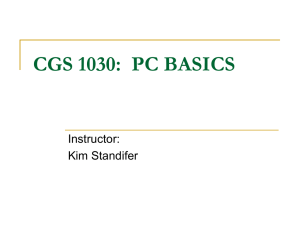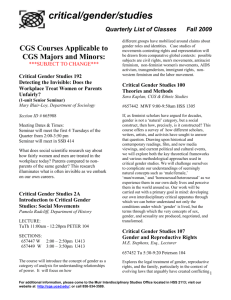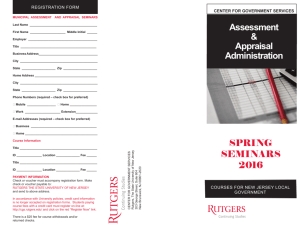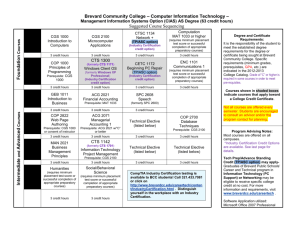POM 104 Syllabus
advertisement
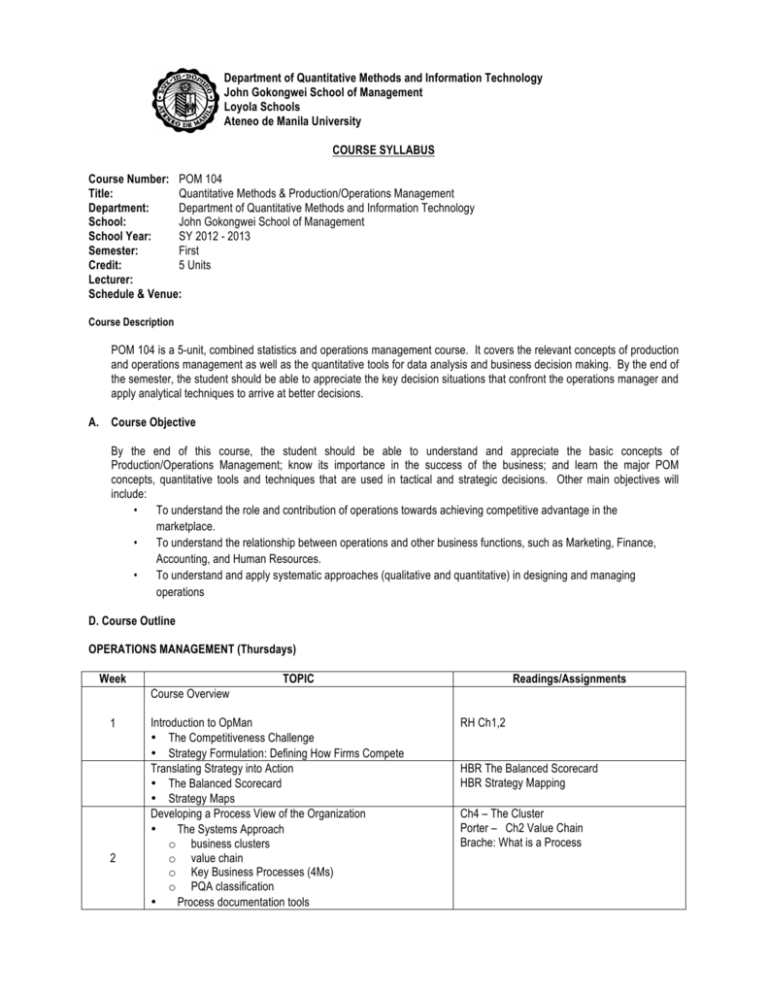
Department of Quantitative Methods and Information Technology John Gokongwei School of Management Loyola Schools Ateneo de Manila University COURSE SYLLABUS Course Number: POM 104 Title: Quantitative Methods & Production/Operations Management Department: Department of Quantitative Methods and Information Technology School: John Gokongwei School of Management School Year: SY 2012 - 2013 Semester: First Credit: 5 Units Lecturer: Schedule & Venue: Course Description POM 104 is a 5-unit, combined statistics and operations management course. It covers the relevant concepts of production and operations management as well as the quantitative tools for data analysis and business decision making. By the end of the semester, the student should be able to appreciate the key decision situations that confront the operations manager and apply analytical techniques to arrive at better decisions. A. Course Objective By the end of this course, the student should be able to understand and appreciate the basic concepts of Production/Operations Management; know its importance in the success of the business; and learn the major POM concepts, quantitative tools and techniques that are used in tactical and strategic decisions. Other main objectives will include: • To understand the role and contribution of operations towards achieving competitive advantage in the marketplace. • To understand the relationship between operations and other business functions, such as Marketing, Finance, Accounting, and Human Resources. • To understand and apply systematic approaches (qualitative and quantitative) in designing and managing operations D. Course Outline OPERATIONS MANAGEMENT (Thursdays) Week TOPIC Readings/Assignments Course Overview 1 2 Introduction to OpMan • The Competitiveness Challenge • Strategy Formulation: Defining How Firms Compete Translating Strategy into Action • The Balanced Scorecard • Strategy Maps Developing a Process View of the Organization • The Systems Approach o business clusters o value chain o Key Business Processes (4Ms) o PQA classification • Process documentation tools RH Ch1,2 HBR The Balanced Scorecard HBR Strategy Mapping Ch4 – The Cluster Porter – Ch2 Value Chain Brache: What is a Process 3/4 5/6 7/8 9/10 11/12 13 • Measuring Process Performance Operations Management: Life Cycle View • Life Cycle Analysis • Key Decision Points in OpMan Product Design • Defining quality: voice of customer • life cycle design • product standards (US, EU, Japan, ISO, BPS/BFAD, Halal, TUV/UL/Medlabs) • House of Quality Service Design • Defining Service Quality • Service Blueprinting Process Design • Work Breakdown Structures • Technology & Innovation o Challenges o Needs Analysis o Evaluation: Business Case Approach • Benchmarking • Building Quality into Processes o Failure Mode and Effects Analysis o Pokayoke Methods Human Resources Planning Job Design • Work Measurement • Work Methods • Learning Curve Analysis Quality Management • Defining Quality • Cost of Quality • TQM Tools • 6-Sigma Overview • Recognizing Quality o Malcolm Baldrige Award o ISO Certification EXAM 1 Capacity Management • Demand Analysis: Forecasting Techniques • Aggregate Planning & Capacity Options • Measuring Capacity: Bottleneck Analysis • Right-sizing: Break-even Analysis • Waiting Line Management Facility Planning & Management • Location Planning o selection criteria o EIA/ECC o evaluation techniques • Workplace Design o Ergonomics – Human Factors Engineering o Occupational Safety and Health o Security Management • Facility Layout o Design Objectives: Load Distance Concept o Layout Options Production Planning & Scheduling RH Ch5 UNIDO 05 RH Ch7 UNIDO 03, 04, 06, 10 RH Ch10 UNIDO 13, 14 RH Ch6 RH Ch4, Sup7, 13 UNIDO 08, 11, 12 RH Ch8 UNIDO 15, 16 RH Ch9 UNIDO 07 RH Ch3, 15 • PERT-CPM • Job Scheduling Materials Management • Unit Load Handling • Alternative Technologies 14/15 16 Supply Chain Management • Supplier Management • Just-in-Time and Lean Operations • Inventory Management (Independent Demand) o ABC Analysis o Single Period – Newsboy Problem o EOQ models o Multi-level inventory issues • Material Requirements Planning (Dependent Demand) EXAM 2 Managing Outbound Logistics • Transportation Model • Vehicle Routing and Scheduling EXAM 3 (Option) Materials Handling Ch2,3 RH Ch11, 12, 14,16 UNIDO 09, RH Supp C, Tutorial 5 REFERENCES: Operations Management o Render & Heizer, Operations Management 10e, Pearson Southeast Asia 2011. o United Nations Industrial Development Organization (UNIDO), Investment Project Preparation and Appraisal, Module3 – Technical Analysis, Vienna 2005. o NOTE: Readings will be uploaded to e-group BUSINESS STATISTICS (Tuesdays) Topics and Coverage Introduction to Business Statistics ● Management Decisions and Business Research ● Statistical Research Process ● Overview of Statistical Tools ● Data Types and Sources ● Survey Questionnaire Design Descriptive Statistics ● Tabular Methods ● Visual and Graphical Methods ● Numerical Methods Introduction to Probability ● Concept of Probability ● Properties of Sample Spaces and Events ● Counting Techniques ● Conditional Probability and Bayes’ Theorem Introduction to Decision Analysis ● Decision Trees ● Decision Criteria ● Perfect and Imperfect Information Reference Supplementary Notes CGS Ch1 PSB Ch3 Chapter 1 CGS Ch2 Creating Charts in Excel Chapter 2-3 MSS Ch5,6 PSB Ch5 Chapter 4 Chapter 19 Discrete Probability Distributions ● Properties of Discrete Probability Distributions ● Binomial Distribution ● Poisson Distribution ● Poisson Approximation to Binomial Continuous Probability Distributions ● Properties of Continuous Probability Distributions ● Uniform Distribution ● Exponential Distribution ● Normal Distribution ● Normal Approximation to the Binomial ● Triangular Distribution Chi-Square Tests (Goodness of Fit) LONG TEST 1 Sampling Distribution ● Sampling Distribution of the Sample Mean ● Sampling Distribution of the Sample Proportion Confidence Intervals ● Confidence Intervals for the Population Mean ● Confidence Intervals for the Population Proportion ● Sample Size Determination Hypothesis Testing ● Developing the Null and Alternative Hypotheses ● Type I and Type II Errors ● One-Tailed Tests/Two-Tailed Tests Two-Population Hypothesis Testing (Optional: Excel/MegaStat) ● Independent Samples ● Paired Differences/Matched Samples LONG TEST 2 Chi-Square Tests ● Tests for Independence Analysis of Variance ● Basic Concepts of Experimental Design ● One-Way Analysis of Variance (Completely Randomized Design) ● Randomized Block Design ● Factorial Design CGS Ch5 Chapter 5 CGS Ch5 Chapter 6 CGS Ch6 Chapter 7 Chapter 8 CGS Ch7 MSS Ch7 PSB Ch7,8 CGS Ch8 MSS Ch8 Chapter 9 CGS Ch9 Chapter 10 PSB Ch9 Chapter 12 CGS Ch10 PSB Ch14,15 Chapter 11 Simple Linear Regression ● Simple Linear Regression Model ● Model Assumptions Chapter 13 ● Testing the Significance of the Slope, Intercept and Model LONG TEST 3 CGS Ch11 MSS Ch9 PSB Ch10,11 REFERENCES: Business Statistics o Bowerman ,O’Connell and Murphree. Business Statistics in Practice. 6th Edition, McGraw-Hill Irwin, 2011. Suggested Readings CGS MSS PSB DAM Larry Gonick & Woollcott Smith. Cartoon Guide to Statistics, Harper-Collins Publishers 1983. Michael Wood. Making Sense of Statistics – A Non-Mathematical Approach, Palgrave-MacMillan, 2003. Moore, McCabe, Alwan, Craig, Duckworth. The Practice of Statistics for Business and Economics, W.H. Freeman & Company, 2011. Albright, Winston, Zappe. Data Analysis for Managers wtih Microsoft Excel, 2e. F. Course Requirements & Grade Equivalents Group Project Partial Papers Final Paper Final Presentation Departmental Exams (5@15%) Quizzes, HW & Class Participation Total 15% 3% 6% 6% 75% 10% 100% 3.71 – 4.00 3.31 – 3.70 2.81 – 3.30 2.31 – 2.80 1.81 – 2.30 0.81 – 1.80 0.00 – 0.80 A B+ B C+ C D F G. Classroom Policies 1. Attendance will be checked regularly. A student who is not in the room during attendance check will be considered absent. A student is entitled to a maximum of six (6) cuts 2. The use of cellphones, ipods, MP3 players, and other electronic devices other than laptops or calculators is strictly prohibited. For any violation, the student concerned will be asked to leave the classroom and will be marked absent for the meeting. 3. The SOM dress code will be strictly followed. A student in inappropriate attire will be asked to leave the classroom and will be marked absent for the meeting. 4. Academic dishonesty in any form will warrant a grade of F for the requirement. In case the violation is committed in a major requirement (long tests, group project), the grade of F will be for the entire course. 5. Group Project: Enterprise Start-up Each group is required to submit partial project papers to serve as periodic updates of their progress in completing the Company Audit. These project papers will be graded - The final written paper should follow the format discussed in class. There will be a mock defense (classroom presentation of the Company Audit) prior to the final oral presentation. The final oral presentation will be graded by an outside panel of judges - Each student will be asked to force rank their group members at the end of the semester. Grades for group work will be adjusted upward or downward to account for each individual’s relative contribution to the group effort H. Consultation Hours TTh, 1030am -1200nn or by appointment
